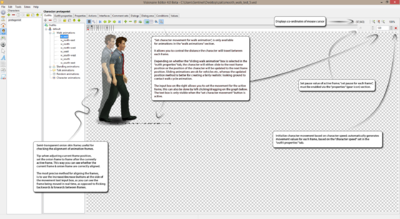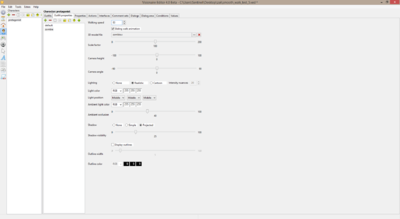Characters Tab
From The Official Visionaire Studio: Adventure Game Engine Wiki
| Characters: This is where you can create your characters, outfits, & animations etc... | |
Contents
Outfits
| Create new entry: add a new animation to one of the character animation sections. | |
| Remove selected entry: delete the selected animation. | |
| Rename selected entry: rename the selected animation. | |
| Duplicate selected entry: create a duplicate of the selected animation. | |
| Copy selected entry to clipboard: copy selected animation to memory. | |
| Paste selected entry from clipboard: paste currently stored animation from memory; must be an animation. | |
| Copy selected entry to clipboard: copy selected animation to memory. | |
| Move selected entry up: shift the selected animation up the list by 1 position. | |
| Move selected entry down: shift the selected animation down the list by 1 position. | |
| Edit animation: this shows the animation preview screen, where you can preview, or edit the animation. | |
| Properties: allows you to edit loop amount, direction, frame delay value, & various playback settings, such as: play forwards, reverse, or random frame selection. | |
| First frame: jump back to the first frame. | |
| Previous frame: jump back 1 frame. | |
| Play animation: allows you to preview the animation. | |
| Next frame: jump forward 1 frame. | |
| Last frame: jump forward to the last frame. | |
| Add frame: opens load graphic box, import image, & edit settings for a single frame | |
| Delete frame: delete the currently selected frame. | |
| Edit frame: opens load graphic box, replace current image, edit various settings, & create custom actions, for the currently selected frame. | |
| Load frame sequence: allows you to batch import animation frame images; images must contain same name with a prefix index number like so: walk_west_01, walk_west_02, ..., walk_west_10, etc... | |
| Onion effect: allows you to display a semi-transparent version, of whichever animation frame you assign the red • dot to. | |
| Set animation center: controls the current position of the character, & is used for detecting when character enters an action area, or reaches a destination; should be set somewhere near the characters feet, in the center. | |
| Animation studio: opens the animation studio window, which allows you to harmonize current character animation center, to another character animation; useful for checking if character animations are correctly aligned. | |
| Set character movement for walk animation: control the movement/position, of the character between frames, preview what character will look like walking across the screen; only available for walk animations. | |
| Zoom in: zoom in to the character animation; max zoom of 400%. | |
| ZoomOriginalButton: reset zoom back to actual character size. | |
| Zoom out: zoom in to the character animation; min zoom of 25%. | |
| Initialize character movement based on character speed of outfit: automatically create movement points between frames based on character speed, set in outfit properties tab; only available when set character movement is enabled. | |
| Animation frames: the black • signifies the active frame. | |
| Animation frames with onion effect enabled: the red • signifies the active semi-transparent onion frame. | |
Properties
| Pauses [msec]: set the global pause value between animation frames in milliseconds; in other words: it determines how long each frame will be shown for. | |
| Play forwards: loops through the animation forwards; the way it was intended to be played. | |
| Play backwards: loops through the animation in reverse; for people who want to travel backwards through time, or for people who are called Tom. | |
| Play in random order: this creates a random pause (between 5 & 20 seconds) between animation loops; useful for randomly triggering environmental scene animations. | |
| Set pause for each frame: this allows you to create individual pause values for each animation frame; overrides the pauses [msec] value above. | |
| Direction of animation: allows you to set the alignment of the currently selected animation. | |
| Start action after animation has finished: allows you link to a previously created action, which will be executed after the animation has finished playing; does not work for animations in the walk, standing, or talking animation sections. | |
| Mirror following animation: mirrors the linked animation, so you don't have to create individual animations for each direction; this will cause issues with Lua scripts that require access to character animations, or specific character animation frames. |
Add/Edit Frame
Both add frame & edit frame use the 'Load graphic window; in the case of edit frame the animation frame preview will already be shown as the link to the graphic is already set & all settings, actions etc, will be as you left them after importing a new frame, or editing the selected frame.
| Transparency [ none ]: don't use use transparency for current animation frame; ok for solid images that do not contain any transparent background parts. | |
| Transparency [ alpha channel ]: uses images alpha channel for transparency; if available. | |
| Transparency [ color ]: allows you to set the background color mask; old school masking method in which the all parts containing the specified color will be ignored. | |
| Sound file: allows you to add a single sound file that will be triggered when the animation frame is shown. | |
| Action: allows you to create actions via the animation frame action window, which will be executed when the animation frame is shown. | |
| Volume: allows you to set the volume level of the sound file; providing you have added a sound file. | |
| Balance: allows you offset the balance (left/right) of the sound file; providing you have added a sound file. | |
| OK: apply the changes & close the window. | |
| Cancel: undo the changes & close the window. |
Animation Studio (harmonizer)
The Animation Studio (aka the harmonizer) is used for making sure your character animations are all correctly aligned. It allows you to compare the currently selected animation with other animation by selecting them from a drop down menu. You can also adjust the character center with this tool.
| Current animation: adjust the current frame, play/stop the animation, or update the character center for the current animation. | |
| Adjust to: select & display another character animation to compare the current animation to. | |
| Selected animation: adjust the current frame, or play/stop the animation for the selected animation. | |
| Visibility [ Current animation ]: adjust the opacity level of the current animation. | |
| Visibility [ Selected animation ]: adjust the opacity level of the selected animation. | |
| OK: apply current changes & close the window. | |
| Cancel: undo current changes & close the window. |
Outfit Properties
| Walking speed: set the default walking speed of the selected character outfit. |
| Sliding walk animation: if true then the character will slide between frames while walking, else the characters position will only be updated on each new frame. |
| 3D model file: load in a 3D character or object file here. |
| Scale factor: define the default size [%] of the linked 3D model. |
| Camera height: height of the cameras focal point; relative to the height of the character. |
| Camera angle: tilt angle of the camera; -90 = bottom upwards, 0 = center, +90 = top downwards. |
| Lighting: determines how the character is shaded. |
| Lighting [ none ]: displays the character without shading. |
| Lighting [ realistic ]: uses realistic diffuse shading to display the character. |
| Lighting [ cartoon ]: display the character with cartoon-like shading & hard intensity transitions. |
| Lighting [ intensity nuances ]: defines the amount of different intensity nuances which will be used for cartoon-like shading. |
| Light color: defines the color of the directional light source; has both RGB & HSV color options. |
| Light position: defines the position of the light source. |
| Ambient light color: defines the ambient light color & controls the basic brightness of the character. |
| Ambient occlusion: defines the self-shadowing amount of the character. |

